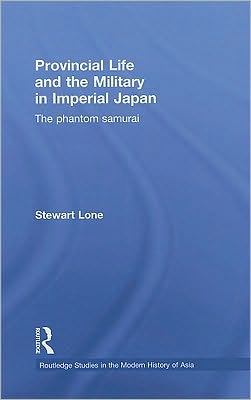

 |

|

The average rating for Provincial Life and the Military in Imperial Japan: The Civil-Military Contract based on 2 reviews is 3 stars.
Review # 1 was written on 2011-01-01 00:00:00 David Schlesinger David SchlesingerWhile reading this book, I was alternating between giggling and trying not to tear my hair out (and really, this is not a suitable thing to do at a kendo taikai or any place that isn't your home). I was giggling because of sheer happiness at being able to read such a well-written book/thesis after so long, and close to tearing my hair out because this was the book I was searching for for the past two years. You see, in IB, we have to do an Extended Essay in order to graduate (it's basically a 4000 word research paper). My paper was on the difference Eastern and Western writers treat the Judas figure, and for my "Easter Author", I chose Endo Shusaku, specifically his book Silence. Which, of all things, is about the kakure kirishitan (do you sense my fustration now?). There was an amazing lack of literature on both books, and I would have really liked to have read this book while I was searching for background information. This book mentions not only Endo Shusaku, but Silence quite a few times. Plus, it has very useful information that I could use to reinforce my point about my analysis of certain characters. -resists the urge to tear hair out- But, honestly, I'm glad that I read this book, even if it's too late for IB. This book looks at the historical background to the kakure kirishitan, from being an underground community due to persecution to choosing not to rejoin the Catholic Church, their organisation and an indepth look at their rituals and artifects, especially the "gozensama." I really enjoyed the comparison between the Catholicism and Kakure (and to a smaller extent, Shintoism and Buddhism), because that helped me understand their uniqueness better. Ok, ok, I'll explain about the kakure kirishitan. The kanji for kakure is this: 隠れand it basically means hidden, so they're the "hidden Christians." After Ieyasu expelled the foreign priests, Christianity was banned and the existing Christians were forced to go underground and adapt. In order not to be discovered, they developed their own way of worship that you could say is distinct from Christianity. And while most of the underground Christians chose to rejoin the Catholic Church when the ban was no longer enforced, a few of them chose to remain secluded, becoming the kakure kirishitan. The book uses a combination of primary sources consisting of interviews with the remaining kakure kirishitans and original documents (I assume copies of them?) and secondary sources from other scholars. Apparently, the community is in decline so I'm glad that there are a group of people learning about them before they vanish completely. So even this book is an academic work (it started off as a PhD thesis), it's still a very interesting book. I don't think the kakure kirishitan's a very well-known (well, English works are hard to find), so if you happen to need a secondary source for this subject, you really need to get your hands on a copy of this book. First posted at With Love from Japan, Eustacia |
Review # 2 was written on 2012-09-27 00:00:00 Pierre Magnan Pierre MagnanThe kind of book that reminds me that when theories are applied on archaeological studies in a good way, the result can be great. |
CAN'T FIND WHAT YOU'RE LOOKING FOR? CLICK HERE!!!